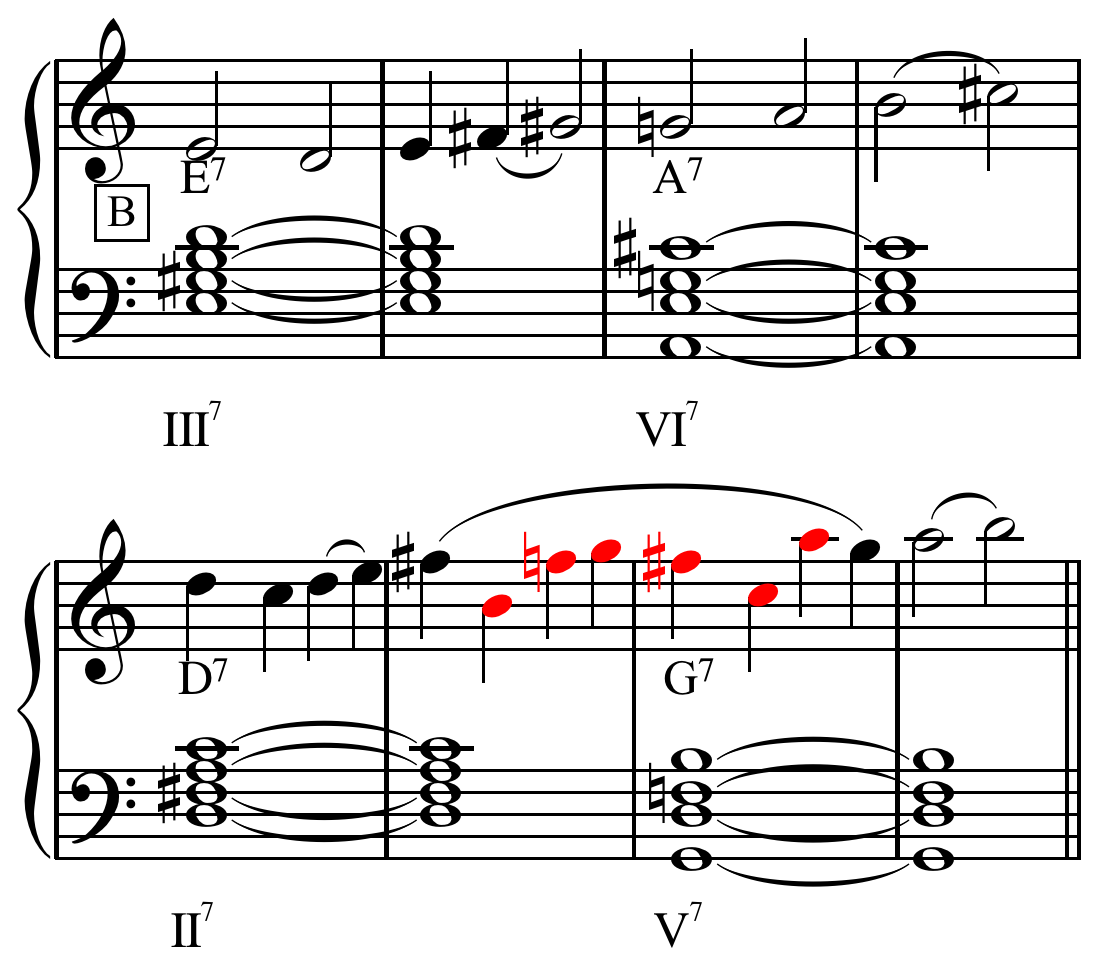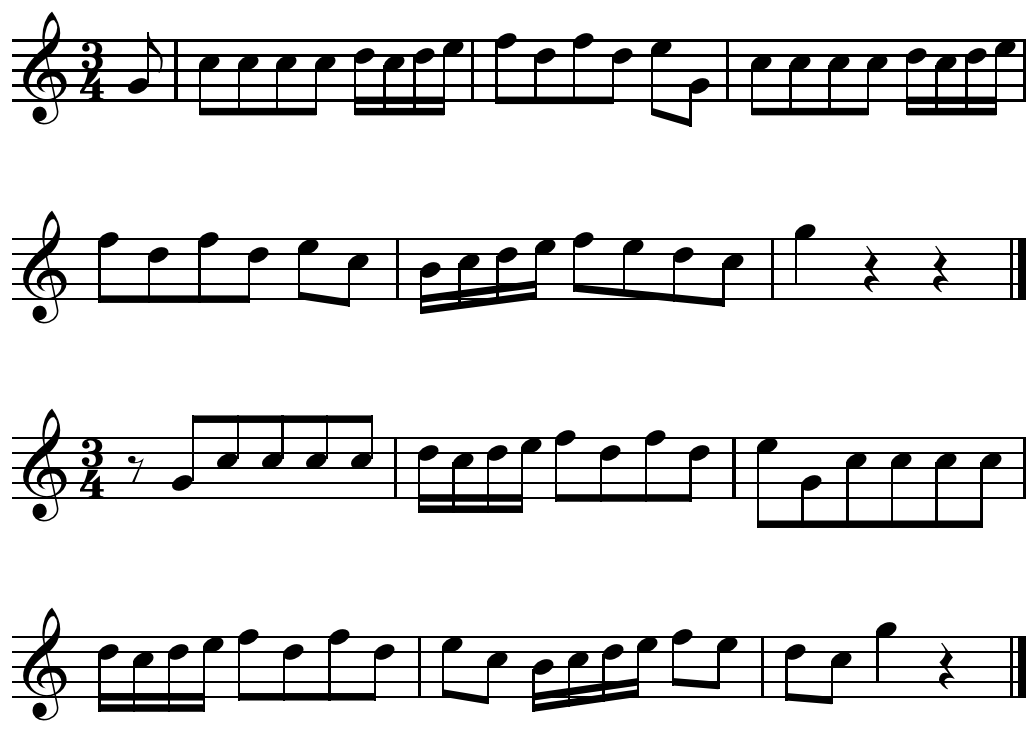Bar-line Shift on:
[Wikipedia]
[Google]
[Amazon]
 In
In  Outside of jazz, a bar-line shift may be less than a bar, causing a change in the metric accent of the
Outside of jazz, a bar-line shift may be less than a bar, causing a change in the metric accent of the
 In
In jazz
Jazz is a music genre that originated in the African-American communities of New Orleans, Louisiana, in the late 19th and early 20th centuries. Its roots are in blues, ragtime, European harmony, African rhythmic rituals, spirituals, h ...
, a bar-line shift is a technique in which, during improvisation
Improvisation, often shortened to improv, is the activity of making or doing something not planned beforehand, using whatever can be found. The origin of the word itself is in the Latin "improvisus", which literally means un-foreseen. Improvis ...
, one plays the chord from the measure before, as an anticipation of a chord, or after the given chord, as a delay, either intentionally or as an "accident." Coker, Jerry (1997). ''Elements of the Jazz Language for the Developing Improvisor'', p.83. .
Bar-line shifts may be caused by a novice having lost their place in the chord progression
In a musical composition, a chord progression or harmonic progression (informally chord changes, used as a plural, or simply changes) is a succession of chords. Chord progressions are the foundation of harmony in Western musical tradition from ...
, but is most often attributable to: "(1)... harmonic generalization, as in the case of playing a II to V7 (+5, +9) progression I-V-I turnaroundas only a V7 (+5, +9); or (2) the player ''wanted'' to play the previous chord (though it has already transpired), but was either pausing momentarily (as in taking a breath), and decides to adopt the 'better later than never' attitude." An example of a "very intentional" bar-line shift may be found on Cannonball Adderley
Julian Edwin "Cannonball" Adderley (September 15, 1928August 8, 1975) was an American jazz Alto saxophone, alto saxophonist of the hard bop era of the 1950s and 1960s.
Adderley is perhaps best remembered by the general public for the 1966 soul ...
's solo
Solo or SOLO may refer to:
Arts and entertainment Characters
* Han Solo, a ''Star Wars'' character
* Jacen Solo, a Jedi in the non-canonical ''Star Wars Legends'' continuity
* Kylo Ren (Ben Solo), a ''Star Wars'' character
* Napoleon Solo, fr ...
on "So What
So What may refer to:
Law
*Demurrer, colloquially called a "So what?" pleading
Music Albums
* So What (Anti-Nowhere League album), ''So What'' (Anti-Nowhere League album) or the 1981 title song (see below), 2000
* ''So What?: Early Demos and L ...
," "in which he deliberately enters and exits the bridge
A bridge is a structure built to Span (engineering), span a physical obstacle (such as a body of water, valley, road, or railway) without blocking the path underneath. It is constructed for the purpose of providing passage over the obstacle, whi ...
early, causing considerable tension, since the chord of the A section (D-) is one-half step lower than the chord of the bridge (E-)." Other notable performers to use this technique include Charlie Parker
Charles Parker Jr. (August 29, 1920 – March 12, 1955), nicknamed "Bird" or "Yardbird", was an American jazz Saxophone, saxophonist, bandleader, and composer. Parker was a highly influential soloist and leading figure in the development of beb ...
, Coleman Hawkins
Coleman Randolph Hawkins (November 21, 1904 – May 19, 1969), nicknamed "Hawk" and sometimes "Bean", was an American jazz tenor saxophonist.Yanow, Scot"Coleman Hawkins: Artist Biography" AllMusic. Retrieved December 27, 2013. One of the first ...
, and Pat Metheny
Patrick Bruce Metheny ( ; born August 12, 1954) is an American jazz guitarist and composer.
He was the leader of the Pat Metheny Group (1977–2010) and continues to work in various small-combo, duet, and solo settings, as well as other side pr ...
.
 Outside of jazz, a bar-line shift may be less than a bar, causing a change in the metric accent of the
Outside of jazz, a bar-line shift may be less than a bar, causing a change in the metric accent of the melody
A melody (), also tune, voice, or line, is a linear succession of musical tones that the listener perceives as a single entity. In its most literal sense, a melody is a combination of Pitch (music), pitch and rhythm, while more figurativel ...
and its cadence
In Classical music, Western musical theory, a cadence () is the end of a Phrase (music), phrase in which the melody or harmony creates a sense of full or partial resolution (music), resolution, especially in music of the 16th century onwards.Don ...
.Newman, William S. (1995). ''Beethoven on Beethoven: Playing His Piano Music His Way'', p.170-71. .
See also
*Side-slipping
In jazz musical improvisation, improvisation, outside playing describes approaches where one plays over a scale, mode or chord that is harmonically distant from the given chord (music), chord. There are several common techniques to playing outside, ...
Sources